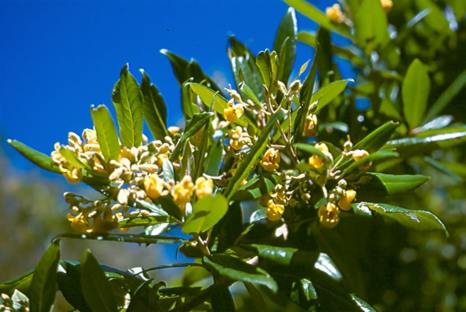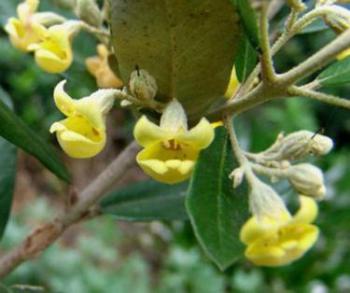Anastrabe integerrima
Anastrabe integerrima E.Mey. ex Benth.
Family: Stilbaceae
Common names: pambati tree (Eng.); isipambatihout , pambatihout , pambatieboom (Afr.); isiBhembedu, isiNqunjana (Z); isiPambatho (Z, X)
SA Tree No: 671
Introduction
With its clusters of custard-yellow pouch-shaped flowers combined with very attractive leaves that contrast their dark green tops with silvery white and felt-like undersides, Anastrabe integerrima is an attractive, versatile addition to any garden.

Description
Description
This multi-stemmed, long flowering, evergreen shrub, or small tree, has a compact root system making it ideal for the smaller garden. In gardens it reaches an average height of 3 to 5 m, in its natural forested habitat this can increase up to 10 m, sometimes more. Anastrabe responds well to being pruned, so this shrub's height can easily be controlled to suit whatever the garden situation requires. The bark is pale grey-brown and sparsely warty. Leaves are stiff, usually opposite, elliptic, dark green and glossy above, paler beneath (either silvery white or light creamybrown), felted with hairs, and dotted above and below with yellow glands. The leaf margins are entire and rolled under, sometimes serrated (regularly toothed like a saw), tapering to a bristle tip and more broadly rounded at the base with a noticeable midrib.
Yellow, fragrant flowers with a reddish-streaked throat and a scarlet blotch inside hang in clusters at branch tips or in leaf axils from October to May. They are noticeably unusual in that they are globular or bell-shaped with the lower corolla lip inflated to form a deep pouch and the upper two-lobed corolla lip held erect.

From January to July the plant produces numerous small seeds held within an oval capsule, up to 8 mm long, surrounded by the persistent calyx. Seeds are released as the capsule dries out.
Conservation Status
Status
This South African endemic is listed as Least Concern (LC) on our Red List.
Distribution and habitat
Distribution description
Found in coastal forest and on drier forest margins as well as in wooded ravines and along streams. It also favours sandstone cliffs and rocky outcrops. Found from the coastal areas up to 1200 m in altitude from the Eastern Cape to KwaZulu-Natal.
Derivation of name and historical aspects
History
The name Anastrabe is derived from the Greek ana-, meaning 'up' or 'back again' and strabos, meaning 'distorted, oblique or squint-eyed', probably referring to the unequal stamens where the larger pair curve around the shorter pair. The species name means 'very entire', and is derived from the Latin integer, entire, undivided, complete, which refers to the entire (even, without teeth) leaf margins.
This genus was until recently classified in the Scrophulariaceae, which is large family, consisting mainly of herbs and shrubs. It is well known for its exotic members such as the snapdragon and foxglove. It is a large family of ± 290 genera and ± 4500 species widespread but mainly in temperate areas and on tropical mountains. In southern Africa there are ± 80 genera and ± 760 species spread throughout the region. Trees are quite rare in this family; most of the members are herbaceous. Some well known indigenous genera within this family are Freylinia, Phygelius, Nemesia, Diascia and Sutera . Recent molecular studies have resulted in this genus, Anastrabe, being moved to the Stilbaceae. Anastrabe has only one species, A.integerrima.
Anastrabe is very similar to Bowkeria, another genus within this family. The most easily identifiable characteristic for a gardener to distinguish between the two, are the leaf arrangement and the flower colour. Anastrabe has yellow flowers and opposite leaves, and although Bowkeria citrina too has yellow flowers, its leaf arrangement is quite different. Bowkeria cymosa and B. verticillata have ternate leaves (arranged in whorls of three) and white flowers to distinguish themselves from Anastrabe , but a similar patterning of reddish or scarlet spots and/or streaks occurs on the inside of the corolla pouch.

Ecology
Ecology
Seeds are dispersed from a dehiscent (opening spontaneously when ripe) capsule.
Uses
Use
Anastrabe integerrima has considerable value as a horticultural subject with its attractive flowers and foliage and versatility of use. The wood is hard and termite-resistant and is traditionally used to make spoons.
Growing Anastrabe integerrima
Grow
Anastrabe integerrima is fairly hardy and easy to grow, and thrives under many different conditions, such as full sun and semi-shade. It is fast-growing and performs best in well-draining nutrient-rich loam with water provided all year round, although it tolerates periods of drought. It is relatively hardy to frost but requires protection when young. It can be pruned to shape, even clipped into a hedge and it is an ideal screening plant for small gardens as it can be planted to hide any structures or walls; one can even try pruning it into a single-stemmed tree. It is pretty enough to be used as a single specimen for the smaller garden, or it can also be planted in groups within a larger landscape. It can also be used in the fynbos garden [run on]or in a mixed informal bed, planted at the back with smaller shrubs and herbaceous perennials in front. The plants also do well in containers on the patio. They are highly versatile and decorative shrubs and will work in most garden designs.
The foliage provides a wonderful two-tone, green and grey contrast within the garden's colour palate, and the lovely flowers contribute yellowish and golden tones.
Anastrabe integerrima is grown easily from seeds and cuttings. It will flower in the first three years if grown from seed, and within the first year if grown vegetatively from cuttings or truncheons.
Collect fruit in autumn while still slightly green and keep in a paper bag to catch the fine seed. Place the bag somewhere warm so that the seeds can dry completely. Once the seed capsules are brown, break them open and shake the seeds out, then move the bag to a cool dry place for storage. Seed should be sown in spring or early summer using a well-draining potting mix. They are Light germinators! Therefore: sprinkle the seed only on the surface of the substrate, slightly press on and place in a ventilated position to avoid fungal infection. The seed germinates easily, usually within three to six weeks. Seedlings can be transplanted as soon as they are strong enough. Under suitable conditions young plants grow fast.
Semi-mature stem cuttings can be taken in spring to early summer (September to November) or in autumn (March to May). These cuttings can be treated with a rooting hormone to help stimulate rooting. Plant in well-draining medium and keep damp, but not wet, in a warm, but well lit and wellventilated area, with no direct sunlight. The cuttings will root in about four weeks in a mist unit, but will take longer within a home garden situation without the use of bottom heat. Once the cuttings have rooted, place them in a slightly shaded area to harden off for three weeks before potting. Pot the rooted plants in a sandy soil mix and place in the shade for another two weeks before exposing them to direct sunlight. Thereafter the plants will be ready for planting. A monthly feeding of an organic fertiliser can be used to help with the growth of the plant.
References
- Angiosperm Phylogeny Group (2009). "An update of the Angiosperm Phylogeny Group classification for the orders and families of flowering plants: APG III". Botanical Journal of the Linnean Society. 161 (2)
- Hilliard, B. 1969. Notes Royal Botanical Garden of Edinburgh . 29: 1-14.
- Johnson, D. & Johnson, S.1993. Gardening with indigenous trees and shrubs. Southern Book Publishers, Cape Town.
- Leistner, O.A. (ed.). 2000. Seed plants of southern Africa: families and genera. Strelitzia 10. National Botanical Institute, Pretoria.
- Manning, J. 2001. Eastern Cape wild flower guide. Botanical Society of South Africa, Cape Town.
- Pooley, E. 1993. The complete field guide to trees of Natal, Zululand and Transkei. Natal Flora Publication Trust, Durban.
- Powrie, F. 1998. Grow South African Plants. A gardener's companion to indigenous plants. National Botanical Institute, Cape Town.
- Raimondo, D. et al. 2009. Red list of South African plants. Strelitzia 25. SANBI (South African National Biodiversity Institute), Pretoria.
Credits
Cherise Viljoen
Kirstenbosch National Botanical Garden
December 2012
updated March 2018
Plant Attributes:
Plant Type: Shrub, Tree
SA Distribution: Eastern Cape, KwaZulu-Natal
Soil type: Sandy, Clay, Loam
Flowering season: Late Summer, Autumn
PH: Neutral
Flower colour: Yellow
Aspect: Full Sun, Afternoon Sun (Semi Shade)
Gardening skill: Easy
Special Features:
Horticultural zones








Rate this article
Article well written and informative
Rate this plant
Is this an interesting plant?
Login to add your Comment
Back to topNot registered yet? Click here to register.